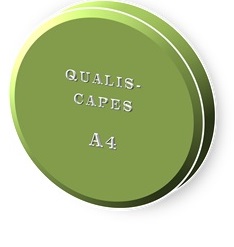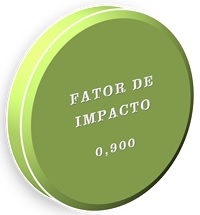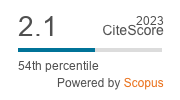Composição bioquímica do plasma seminal de cutias em diferentes condições ambientais da Caatinga
DOI:
https://doi.org/10.1590/1983-21252025v3813015rcPalavras-chave:
Sazonalidade. Dasyprocta leporina. Fisiologia reprodutiva.Resumo
Este estudo visa contribuir para o avanço do conhecimento sobre os aspectos reprodutivos das cutias (Dasyprocta leporina). O objetivo foi descrever os constituintes orgânicos e inorgânicos presentes no plasma seminal de cutias analisados sob diferentes condições ambientais em uma região semiárida. O plasma seminal foi coletado de seis machos adultos por meio de eletroejaculação durante os períodos seco e chuvoso. Foram analisados componentes orgânicos (proteínas totais, albumina, colesterol, triglicerídeos, frutose e glicose) e inorgânicos (fósforo, magnésio, cálcio, ferro, cloretos, sódio e potássio). Detectaram-se maiores concentrações de glicose (88,24 e 26,27 mg/dL), fósforo (66,40 e 3,67 mg/dL) e potássio (92,67 e 19,68 mmol/L) na estação seca em comparação à estação chuvosa. As concentrações de cloreto (43,04 e 201,40 mEq/L) foram maiores na estação chuvosa. Este é o primeiro estudo a descrever a composição bioquímica do plasma seminal nesta espécie, revelando importantes correlações entre esses constituintes e os períodos seco e chuvoso no bioma Caatinga.
Downloads
Referências
BEER-LJUBIĆ, B. et al. Cholesterol concentration in seminal plasma as a predictive tool for quality semen evaluation. Theriogenology, 72: 1132-1140, 2009.
BRINSKO, S. P. et al. Cholesterol-to-phospholipid ratio in whole sperm and seminal plasma from fertile stallions and stallions with unexplained subfertility. Animal Reproduction Science, 99: 65-71, 2007.
BROWN-UDDENBERG, R. C. et al. The Agouti [Dasyprocta leporina, D. aguti] Booklet and Producers Manual. 1st ed. Marabella, Trinidad and Tobago: GWG Publications, 2004. 91 p.
CASTELO, T. S. et al. Interactions among different devices and electrical stimulus on the electroejaculation of captive agoutis (Dasyprocta leporina). Reproduction in Domestic Animals, 50: 492-496, 2015.
CAVAZOS, L. F. Fine structure and functional correlates of male accessory sex glands of rodents. In: GREEP, W. R. O.; ASTWOOD, E. B. (Eds.) Handbook of physiology. Washington DC: American Physiology Society, 1975. v. 5. p. 353-381.
DANTAS, M. R. T. et al. Relationship between season and spermatozoa traits of captive-reared agoutis from Brazilian semiarid. Environmental Science and Pollution Research, 31: 52501-52510, 2024.
DINIZ, J. A. R. A. et al. Reproductive characteristics of female agouti (Dasyprocta prymnolopha) created in captivity in northeast Brazil. Pubvet, 13: 1-8, 2019.
DUBOST, G.; HENRY, O.; COMIZZOLI, P. Seasonality of reproduction in the three largest terrestrial rodents of French Guiana forest. Mammalian Biology, 70: 93-109, 2005.
DUBOST, G.; HENRY, O. Seasonal reproduction in neotropical rainforest mammals. Zoological Studies, 56: e2, 2017.
EMMONS L.; REID F. Dasyprocta leporina. The IUCN Red List of Threatened Species, 2016: e.T89497102A22197762.
ESPÍNOLA SOBRINHO, E. et al. Climatology of precipitation in the city of Mossoró – RN. Period: 1900-2010. In: XVII CONGRESSO BRASILEIRO DE AGROMETEOROLOGIA, 2011, Guarapari. Anais... Guarapari: Incaper, 2011, p. 4.
FOUQUET, J. P. Secretion of free glucose and related carbohydrates in the male accessory organs of rodents. Comparative Biochemistry and Physiology Part A: Physiology, 40: 305-317, 1971.
GAROLLA, A. et al. Impaired sperm function in infertile men relies on the membrane sterol pattern. Andrology, 6: 325-334, 2018.
GUIMARÃES, D. A.; MOREIRA, D.; VALE, W. G. Determination of agouti (Dasyprocta prymnolopha) reproductive cycle by colpocytologyc diagnostic. Acta Amazonica, 27: 55-63, 1997.
JONES K. R.; LALL K. R.; GARCIA G. W. Omnivorous behaviour of the agouti (Dasyprocta leporina): A neotropical rodent with the potential for domestication. Scientifica, 2019: 3759783, 2019.
LIMA, A. G. A. et al. Effect of different anesthetic protocols on erection, ejaculation and sperm parameters in red-rumped agoutis (Dasyprocta leporina) subjected to electroejaculation. Theriogenology Wild, 2: 100020, 2023.
MANN, T.; LUTWAK-MANN, C. Biochemistry of seminal plasma and male accessory fluids; application to andrological problems. In: MANN, T. (Ed.) Male reproductive function and semen. Springer, London: Springer-Verlag Berlin Heidelberg, 1981. v. 1, cap. 9, p. 269-336.
MOLLINEAU, W. et al. The gross anatomy of the male reproductive system of a neotropical rodent: the agouti (Dasyprota leporina). Anatomia, Histologia, Embryologia, 35: 47-52, 2006.
MOLLINEAU, W. M.; ADOGWA, A. O.; GARCIA, G. W. Spermatozoal morphologies and fructose and citric acid concentrations in agouti (Dasyprocta leporina) semen. Animal Reproduction Science, 105: 378-383, 2008.
MOLLINEAU, W. M.; ADOGWA, A. O.; GARCIA, G. W. Improving the efficiency of the preliminary electroejaculation technique developed for semen collection from the agouti (Dasyprocta leporina). Journal of Zoo and Wildlife Medicine, 45: 633-637, 2010.
MOREIRA, S. S J. et al. Composition of collared peccary seminal plasma and sperm motility kinetics in semen obtained during dry and rainy periods in a semiarid biome. Animal Reproduction Science, 211: 106229, 2019.
MOREIRA, S. S. J. et al. Impact of seminal plasma composition on sperm freezability in wild mammals: A review. Biopreservation and Biobanking, 20: 90-96, 2022.
PINHEIRO, M. J. P.; ANDRADE, S. A.; CUNHA, J. N. Preservation and exploitation of native wild animals: cavy, agouti and mocó. Revista Caatinga, 6: 28-49, 1989.
PUROHIT, S. B.; LALORAYA, M.; KUMAR, G. P. Role of ions and ion channels in capacitation and acrosome reaction of spermatozoa. Asian Journal of Andrology, 1: 95-107, 1999.
RODRIGUEZ-MARTINEZ, H. et al. Seminal plasma: relevant for fertility? International Journal of Molecular Sciences, 22: 4368, 2021.
SANCHEZ-RODRIGUEZ, A. et al. Sperm Capacitation and Kinematics in Phodopus Hamsters. International Journal of Molecular Sciences, 24: 16093, 2023.
SILVA, A. M. et al. Cryopreservation of testicular tissue from adult red-rumped agoutis (Dasyprocta leporina Linnaeus, 1758). Animals, 12: 738, 2022.
SILVA, A. E. D. F.; DODE, M. A. M.; UNANIAN, M. M. Reproductive capacity of the beef bull: functions, abnormalities and factors that influence it. Campo Grande, MS: EMBRAPA, 1993. 128 p.
TAKEI, G. L. et al. Hamster sperm possess functional Na+/Ca2+-exchanger 1: its implication in hyperactivation. International Journal of Molecular Sciences, 24: 8905, 2023.
TÖPFER-PETERSEN, E. et al. The role of stallion seminal proteins in fertilisation. Animal Reproduction Science, 89: 159-170, 2005.
Downloads
Publicado
Edição
Seção
Licença
Os Autores que publicam na Revista Caatinga concordam com os seguintes termos:
a) Os Autores mantêm os direitos autorais e concedem à revista o direito de primeira publicação, com o trabalho simultaneamente licenciado sob a Licença Creative Commons do tipo atribuição CC-BY, para todo o conteúdo do periódico, exceto onde estiver identificado, que permite o compartilhamento do trabalho com reconhecimento da autoria e publicação inicial nesta revista, sem fins comerciais.
b) Os Autores têm autorização para distribuição não-exclusiva da versão do trabalho publicada nesta revista (ex.: publicar em repositório institucional ou como capítulo de livro), com reconhecimento de autoria e publicação inicial nesta revista.
c) Os Autores têm permissão e são estimulados a publicar e distribuir seu trabalho online (ex.: em repositórios institucionais ou na sua página pessoal) a qualquer ponto antes ou durante o processo editorial, já que isso pode gerar alterações produtivas, bem como aumentar o impacto e a citação do trabalho publicado (Veja O Efeito do Acesso Livre).







